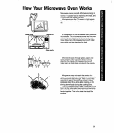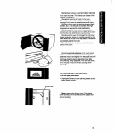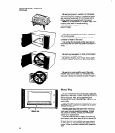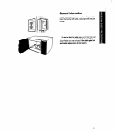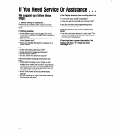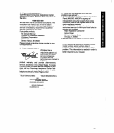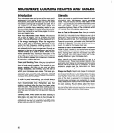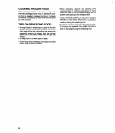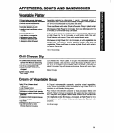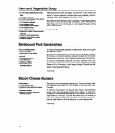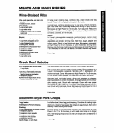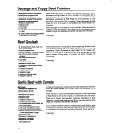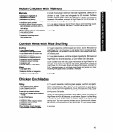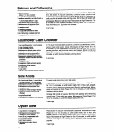
Food Characteristics and Your
Microwave
Many people believe that their job is done once the
food goes into the microwave and the timer is set.
This is far from true. The following techniques are
as important to your cooking as selecting quality
ingredients from the market.
Density: Microwaves penetrate porous foods such
as cakes or breads more easily than heavy foods
such as roasts or casseroles. Dense foods must be
cooked for a longer time, and often at a lower power
setting to avoid uneven cooking.
Starting Temperatures: The initial temperature of
food directly affects the length of time it must cook
or heat. As in a conventional oven, frozen food
takes longer to cook than does refrigerated food,
while food at room temperature cooks most quickly.
Moisture Content: Because microwaves are
attracted to moisture, cooking time will vary accord-
ing to water content. Naturally moist foods such as
vegetables, fish and poultry will cook quickly and
evenly; drier foods such as rice or dried beans
require added moisture for microwave cooking.
Size of Foods: Small, even-sized pieces of food
cook more rapidly than large ones. To ensure even
cooking, cut all pieces of food into similar sizes and
shapes.
Quantity of Foods: Microwave times relate directly
to the amount of food being cooked. Smaller quanti-
ties offood cook faster than large quantities. When
doubling a recipe, increase time by about half and
check for doneness. Add any additional time very
cautiously.
Shape of Foods: Thin parts of uneven foods cook
faster than thick parts. Chicken pieces, fish fillets
and other foods which vary in thickness will take
longer to cook in the thicker portions. To promote
even cooking, arrange foods so that thicker por-
tions are to the outside, where they will absorb more
energy.
Bones and Fat Content in Meat: The bone and fat
distribution affects how evenly meats cook in the
microwave oven. Boneless cuts cook more evenly,
since bones conduct heat to areas near them. Well-
marbled meat cooks more evenly. Large areas of fat
attract energy away from the meat, and slow cook-
ing. To prevent uneven cooking. meats with bones
or large fatty areas may require frequent turning
during microwaving.
Techniques for Microwave
Cooking
Every different food has unique characteristics.
Here are some ideas and guidelines to help you
achieve optimum results from your microwave
oven.
Elevating: As in conventional cooking, foods such
as roasts are elevated so they are not allowed to
steam in their own juices. Turning foods is espe-
cially important here because it allows for more
even cooking. Shielding may also be needed to
prevent overcooking in some smaller areas.
Stirring: As with other cooking methods, prevent
uneven cooking by stirring and rearranging food
while it is cooking. Since the food towards the out-
side of a dish heats first, stir from the outside toward
the center to promote even heat distribution.
Browning: Many microwave utensils are specially
designed to allow browning of some foods. A spe-
cial coating on the bottom of these dishes absorbs
microwave energy to create temperatures high
enough to brown food such as hamburgers, fried
eggs, and grilled sandwiches. Use these utensils
according to manufacturer’s instructions.
Shielding: Certain foods that attract excess micro-
wave energy, such as wing tips and leg ends of
poultry, and the corners of square baking pans, can
be shielded to prevent overcooking. Shielding done
with small pieces of foil will not hurt your oven as
long as they do not touch each other or the sides of
the oven.
Arranging and Spacing: Individual foods like pota-
toes and muffins should be arranged in a circle at
the outside edge of the oven cooking platform. This
will guarantee that all the pieces cook evenly at the
same rate. Foods which are uneven in thickness,
such as chicken wings, should be arranged with the
meatier portions to the outside. Delicate foods like
asparagus tips should be placed toward the inside
of the dish to receive less microwave energy. If
possible, always leave spaces between individual
pieces of food.
37



